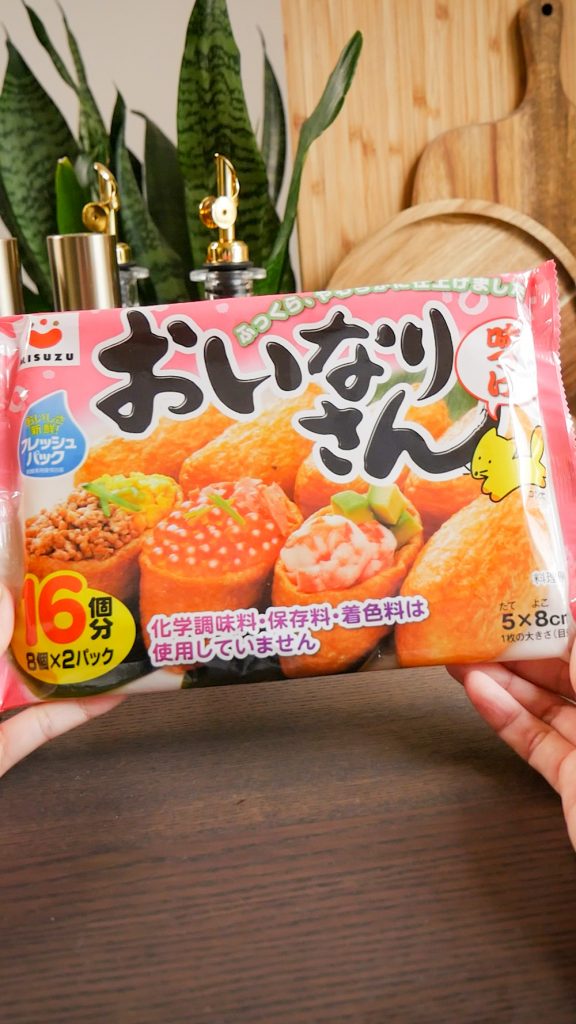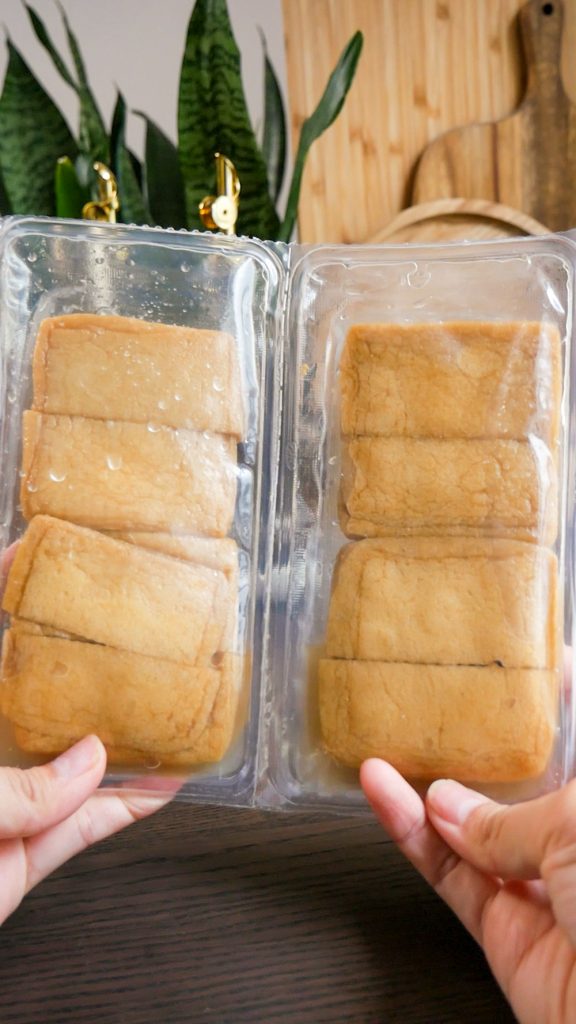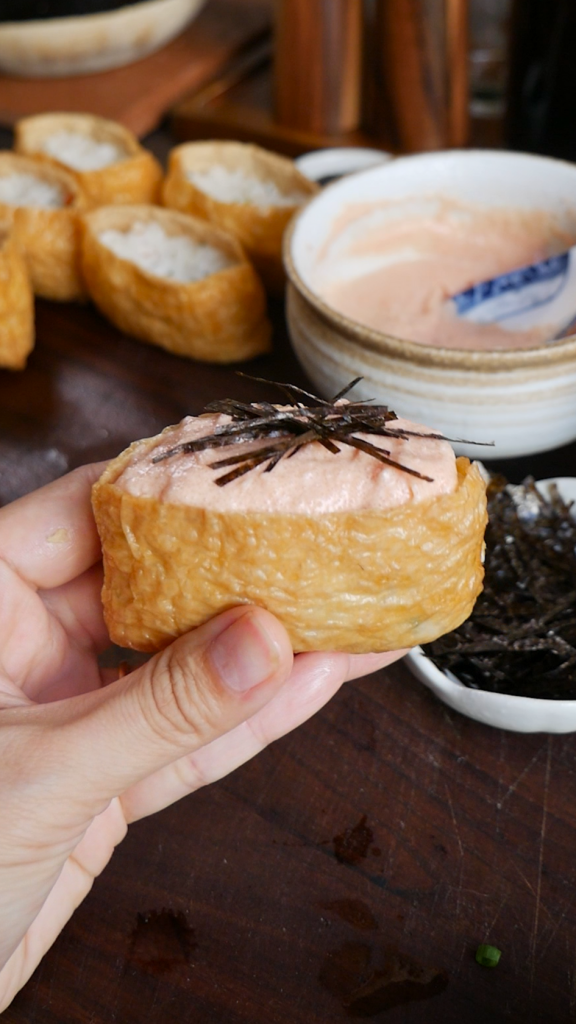Yubuchobap or Korean inari sushi is sweet and savory tofu pockets that are stuffed with seasoned rice and occasionally served with toppings. It translates as tofu (yubu) and sticky rice (chobap) and is similar to inari sushi in Japanese cuisine.
These bite-sized pockets of deliciousness are one of those dishes that once you start, you can’t stop eating. The combination of textures and flavors is hard to resist and best of all, no cooking is required! (except for rice).

Why you’ll love this recipe
Due to the ease of preparation and compact size, yubuchobap is perfect for a quick lunch or on-the-go snack. Whether you’re road-tripping, picnicking, hiking, or in need of a delicious and nutritious lunch, yubuchobap has got you covered. They’re also great for hosting gatherings and dinner parties. Most of the prep can be done in advance, making it a convenient and time-saving dish.
Yubuchobap is commonly eaten with just the tofu pocket and seasoned rice, but I personally think it tastes better with a variety of toppings. The best part is – it’s totally customizable so you can essentially enjoy it with any toppings you prefer! For example, my fiance requested a vegetarian version so I made a quick pickled cucumber topping and it turned out to be one of my favorites. The possibilities are endless!
Where to buy Yubuchobap kits


They are typically sold in kits, which can be usually found in any Korean or Japanese market.



The kit includes the tofu skin, vinegar seasoning, and dried seasoning mix so all you’ll need is to prepare the rice and toppings, which are optional.

Some Japanese kits only come with the tofu skin however, the vinegar seasoning and dried seasoning mix can be easily prepared at home! Be sure to read on to learn more about how you can make this easy and delicious meal.

Yubuchobap Ingredients & Substitutions
Yubuchobap kit: these kits are available in most Korean and Japanese markets. Most of them come with seasoned tofu skin, vinegar seasoning, and dried seasoning mix however, some brands only come with the tofu skin.
To make the vinegar seasoning at home, combine 2 tablespoons rice vinegar (or white vinegar), 1 tablespoon sugar, and 1/2 teaspoon salt. Mix until the sugar and salt has dissolved completely. For the dried seasoning mix, you could mix equal parts sesame seeds and dried seaweed strips or use furikake.
Cooked rice: you’ll want to use short-grain or medium-grain rice for this recipe. I don’t recommend using long-grain rice like basmati or jasmine rice because they don’t contain as much starch as short-grain and medium-grain.
Toppings (Optional)
Marinated Salmon
Sashimi-grade salmon: feel free to swap the salmon with your favorite type of sashimi-grade fish including tuna, yellowtail, scallops, and more!
Soy sauce: the soy sauce is the base of the marinade and is used to season the salmon.
Mirin: the mirin adds a touch of sweetness and also gets rid of any unpleasant odors from the salmon.
Sesame oil: the sesame oil adds bold and nutty flavors to the marinade.
Scallions: scallions are used to add freshness and a pop of contrasting color.
Myeongran (Mentaiko) Mayo
Myeongran-jeot (mentaiko): this is spicy fermented pollock roe which can be found in the frozen section of any Korean or Japanese market.
Kewpie mayo: the kewpie mayo creates a rich and creamy sauce when mixed with the myeongran-jeot. I prefer using Japanese Kewpie mayo because it is richer and sweeter, however, you can use regular mayo.
Seaweed strips: also known as ‘nori’. This is added as a garnish for an extra layer of umami.
Quick Pickled Cucumber
Persian or Indian cucumber: I prefer using Persian or Indian cucumbers because they are slender and thinner compared to other varieties. Their skin is also edible and less bitter.
Salt: the salt is used to draw out the excess moisture in the cucumber as well as add flavor.
Rice vinegar: the rice vinegar adds tanginess to the pickled cucumber. Rice vinegar can be substituted with white vinegar.
Sugar: the sugar is used to balance out the saltiness and tanginess.
Black sesame seeds: the black sesame seeds add a nutty flavor and crunchy texture.

How to prepare Yubuchobap (Korean Inari Sushi)?
Step 1: Prepare the rice.


Place the cooked rice into a large mixing bowl. Pour in the vinegar seasoning packet or homemade vinegar seasoning, and dried seasoning packet. Mix until well combined then set aside to cool completely.
Step 2: Make the toppings.
While the rice is cooling, prepare the toppings, if using.
Marinated Salmon (Makes enough for 8 to 12 pieces)


Combine salmon, soy sauce, mirin, and sesame oil in a small mixing bowl. Mix well then set aside in the fridge to marinate for at least 30 minutes or up to 24 hours. Prepare chopped scallions for garnish.
Myeongran-jeot (Mentaiko) Mayo (Makes enough for 8 to 12 pieces)




Combine myeongran and Kewpie mayo together in a small bowl. Mix well then set aside in the fridge until ready to use. Prepare seaweed strips for garnish
(Vegetarian) Quick Pickled Cucumber (Makes enough for 8 to 12 pieces)


Using a vegetable peeler, carefully peel the cucumbers into thin strips. Transfer to a mixing bowl then add one teaspoon of salt. Toss to mix well then set aside for at least 15 minutes.

After 15 minutes, squeeze the excess water from the cucumbers then transfer to a clean mixing bowl. Add the remaining teaspoon of salt, rice vinegar, sugar, and black sesame seeds. Toss to mix then set aside in the fridge until ready to use.
Step 3: Assemble.


Once the rice has cooled to touch, take 2 to 3 tablespoons of the seasoned rice and stuff them into the tofu pockets. Carefully and gently pack the rice into the tofu pockets, making sure to leave about 1/2 inch space from the top.
Step 4: Add the toppings.



Add your choice of toppings and garnishes.
Step 5: Serve & enjoy.

Serve with a side of wasabi and soy sauce. Enjoy!

Preparation tips for Yubuchobap (Korean Inari Sushi)
- The tofu skin is usually soaked in a vinegar seasoning. Before filling, be sure to drain or gently squeeze the excess liquid to prevent a dripping mess.
- Most kits come with vinegar seasoning and dried seasoning mix however, some do not. The vinegar seasoning can be easily made at home by mixing rice vinegar, salt, and sugar. The exact measurements are listed in the recipe card below! The dried seasoning mix can also be made by mixing sesame seeds and nori strips. Furikake would also work too!
- Feel free to experiment with toppings! Some ideas include tuna poke, canned tuna salad, ikura (salmon roe), and more. To keep it simple, you could also skip the toppings and enjoy it as is.
- I highly recommend having the yubuchobap with a side of wasabi and soy sauce. The spiciness from the wasabi and savoriness from the soy sauce complement the sweetness and tanginess of the tofu skin and seasoned rice.
Frequently Asked Questions
What does yubuchobap taste like?
Yubuchobap is a delightful blend of sweet, savory, and tangy flavors. The tofu skin is deep-fried and then simmered in a sweet soy-based mixture which gives it a slightly sweet and savory flavor. The rice is seasoned with a sweet vinegary mixture made of rice vinegar, sugar, and salt which gives it a tangy, sweet, and salty flavor. To bring it up another notch, the toppings add their own flavors and textures to the yubuchobap. When combined, you get a delicious contrast in textures between the soft tofu pockets, the sticky rice, and the various characteristics of the toppings – whatever that might be.
What’s the difference between yubuchobap and inari sushi?
The primary difference between yubuchobap and inari sushi is linguistic and cultural. Both are very similar and feature seasoned rice in tofu pockets. However, depending on the region, the seasoning of the rice and marinade for the tofu skin may differ.
Based on my personal experience, the rice for Korean yubuchobap usually includes a dried seasoning mix that consists of sesame seeds, dried seaweed, and dried carrots. However, the rice for Japanese inari sushi usually does not.
Additionally, yubuchobap is commonly eaten with a side of wasabi and soy sauce whereas inari sushi is not. While this comes down to a matter of preference, these are the biggest distinctions that I’ve observed.
Can I make my own tofu pockets?
Yes, of course! While you can certainly make them at home, it is time-consuming. For convenience, I recommend buying the kits at your local Korean or Japanese market.
Can I make yubuchobap in advance?
Yes! One of the best things about yubuchobap is that you can make it ahead of time. It’s great to pack for lunch or when you are on the move. For example, road-tripping, hiking, picnicking, traveling, and more!
How can I store yubuchobap?
Although yubuchobap can be made in advance, it’s best eaten the same day that it’s prepared. If you wanted to, however, you could store it in the fridge for up to 2 days. Just be sure to store them in an air-tight container so they stay fresher for longer.
Looking for more easy and delicious Korean-inspired recipes?
Here are some of my most popular recipes!
- Marinated Raw Shrimp – also known as ‘saewoo jang‘ (새우장), is the epitome of authentic Korean cuisine. It’s made with raw succulent shrimp that has been cured in a delicious umami-packed soy marinade. Perfect with a bowl of rice!
- Cold Soba Noodles – this cold soba noodle dish is a meal that’s both filling and light at the same time. It’s great for days when you want something nourishing without feeling weighed down. Best of all, this recipe is incredibly easy to make!
- Korean Pork Bone Soup – better known as ‘gamja tang‘ (감자탕), is a hearty and comforting dish made with tender fall-off-the-bone meat, and an assortment of vegetables, served in a spicy flavorful soup. It’s the ultimate Korean comfort food!
- Bossam (Korean Boiled Pork Belly) – this is a Korean dish made of pork belly or pork shoulder that is boiled in various seasonings and aromatics. It is cooked low and slow, resulting in a flavorful, tender, melt-in-your-mouth bite.
- Japchae Dumplings – If you like japchae and dumplings, this recipe is for you! Plus, it’s vegetarian-friendly.

Yubuchobap Recipe (Korean Inari Sushi)
Ingredients
- 1 yubuchobap kit includes tofu pouches, vinegar seasoning, and dried seasoning packet
- 3-4 cups cooked rice short-grain or medium-grain
Homemade Vinegar Seasoning (Optional)
- 2 tbsp rice vinegar adjust to taste
- 1 tbsp sugar adjust to taste
- 1/2 tsp salt adjust to taste
Toppings (Optional)
Marinated Salmon (makes 8)
- 7 oz (200g) sashimi-grade salmon cut into 1/4 inch cubes
- 3 tsp soy sauce
- 3 tsp mirin
- 3 tsp sesame oil
- chopped scallions for garnish
Myeongran (Mentaiko) Mayo (makes 8)
- 4 oz (120g) myeongran or mentaiko spicy pollock roe
- 4 tbsp Kewpie mayo substitute with regular mayo
- sliced seaweed for garnish
Quick Pickled Cucumber (makes 8)
- 8 Persian or Indian cucumber
- 2 tsp salt divided
- 2 1/2 tbsp rice vinegar
- 4 tsp sugar
- 1 tbsp black sesame seeds
Instructions
- Place the cooked rice into a large mixing bowl. Pour in the vinegar seasoning packet or homemade vinegar seasoning, and dried seasoning packet. Mix until well combined then set aside to cool completely.
- While the rice is cooling, prepare the toppings, if using.
Toppings
- For the marianted salmon topping, combine salmon, soy sauce, mirin, and sesame oil in a small mixing bowl. Mix well then set aside in the fridge to marinate for at least 30 minutes or up to 24 hours.
- For the myeongran (mentaiko) mayo topping, combine myeongran and Kewpie mayo together in a small bowl. Mix to combine then set aside in the fridge until ready to use.
- For the quick pickled cucumber topping, carefully peel the cucumber into thin strips using a peeler. Transfer to a mixing bowl then add 1 tsp of salt. Toss to mix well then set aside for at least 15 minutes. After 15 minutes, squeeze the excess water from the cucumbers then transfer to a clean mixing bowl. Add the remaining teaspoon of salt, rice vinegar, sugar, and black sesame seeds. Toss to mix then set aside in the fridge until ready to use.
Assembling
- Once the rice has cooled to touch, take 2 to 3 tablespoons of the seasoned rice and stuff them into the tofu pockets. Carefully and gently pack the rice into the tofu pockets, making sure to leave about 1/2 inch space from the top.
- Add your choice of toppings and garnishes.
- Serve with a side of wasabi and soy sauce. Enjoy!
